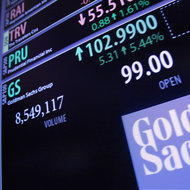Don’t worry about labor force participation. It’s not coming back.
That’s the conclusion of a new piece of economic modeling by the respected St. Louis firm Macroeconomic Advisers. And, if true, it has important implications for the Federal Reserve’s conduct of monetary policy over the next few years. Specifically, it means the monthly pace of job creation so far this year is ample to push the unemployment rate below 6.5 percent by mid-2015.
Let’s take a step back. Lots of people lost jobs during the Great Recession. In the aftermath, the great surprise has been how few are looking for new jobs. Labor force participation, the share of adults working or trying to find work, has stagnated at about 63.5 percent, almost three percentage points below the pre-recession level.
The unemployment rate has dropped almost entirely because of this decline in labor force participation. In other words, it has not fallen because people are finding jobs. It has fallen because fewer people are looking for jobs.
The question is whether that’s a permanent condition. Some economists say that people who have stopped looking for jobs will start looking again as economic conditions improve. If that’s true, it probably means that the Fed should be trying harder to stimulate the economy, because the current pace of job growth would not suffice to return unemployment to normal levels any time soon. As people finding jobs poured out of the unemployment pool, others would be pouring into the pool, keeping the level of unemployment unacceptably high.
Macroeconomic Advisers says, however, that participation is unlikely to increase. Yes, some people will start looking for jobs. But it predicts that will be offset by other trends, like the aging of the population into retirement.
It also points to the growing popularity of federal disability benefits, a program many researchers say is functioning as a safety net for people who can’t find jobs – except that it tends to remove them from the workforce on a permanent basis.
In effect, the model suggests that the Fed is right to focus on the unemployment rate as it decides how long to pursue its various stimulus campaigns.
If the model is right, further declines in unemployment will reflect job growth, not declines in participation. It will mean that things are actually getting better.
At the same time, if the model is right, the recovery will only go so far. Participation is in long-term decline, and the Fed can do nothing about it.
If the economy adds an average of 170,000 jobs a month over the next two years – well below the 200,000 per month pace so far this year – the unemployment rate will fall to 6.5 percent by mid-2015. The Fed’s chairman, Ben S. Bernanke, said yesterday that he thought the rate should end up around 5.6 percent.
We’ll have less unemployment, and less employment, and that will be that.
Article source: http://economix.blogs.nytimes.com/2013/07/18/labor-force-participation-is-not-coming-back/?partner=rss&emc=rss



